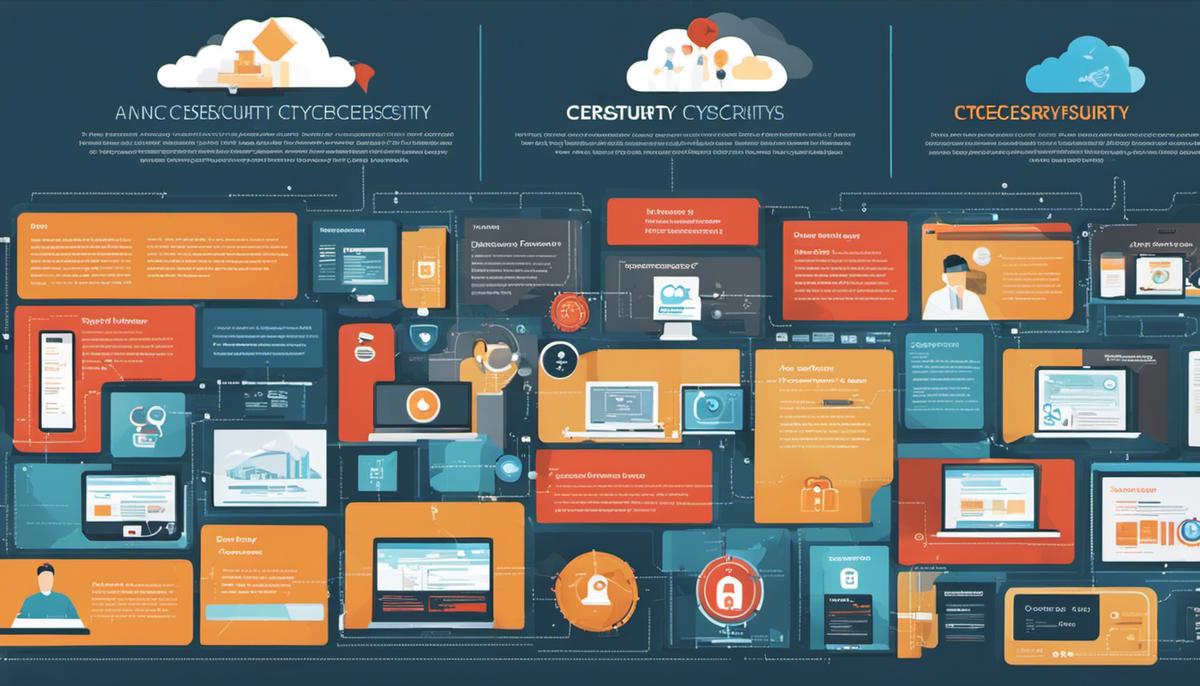In the ever-evolving landscape of digital technology, the need for safeguarding sensitive information has never been more crucial. The role of a Cybersecurity Analyst stands at the heart of this digital fortress, and it’s a job demanding an intricate blend of technical competency and analytical expertise. This article delves into the fundamentals of a Cybersecurity Analyst’s role, the extensive skill set required, the emerging trends in the cybersecurity sector, and potential career opportunities. Furthermore, it briefly touches upon the challenges faced by professionals in this field and possible mitigation strategies.
Cybersecurity Analyst Job Description
The Essential Roles and Responsibilities of a Cybersecurity Analyst
In the fast-paced, high-tech world of today, cybersecurity is more important than ever before. It’s the end line of defense against ever-evolving threats to our digital landscape. Tasked with the crucial role in this deterrent force are cybersecurity analysts. But what exactly are the primary functions of these digital guardians?
Cybersecurity analysts play the essential role of protectors of sensitive information. Their foremost responsibility is to safeguard an organization’s data from a host of potential threats. Methodical, meticulous vulnerability testing is a key part of an analyst’s job to ensure systems and networks remain impervious to breaches. They proactively identify weak points and create robust security measures to uphold system integrity.
Part of being on the offense is staying ahead of the curve. Cybersecurity analysts understand the importance of staying updated with the latest trends and advancements in information technology and cybersecurity. New threats emerge almost as fast as new technology; keeping abreast of these trends enables analysts to anticipate potential vulnerabilities and take pre-emptive action.
In the event of a security breach, swift response and efficient problem resolution is crucial. A cybersecurity analyst is responsible for immediate incident response to quickly quarantine and resolve the problem to prevent further damage or loss of data. Following a breach, analysts conduct comprehensive post-incident analysis. They dissect the attack in detail to understand its nature, how it succeeded, and how similar future attacks can be prevented.
Instead of hoping to thwart every threat, the astute cybersecurity analyst also prioritizes risk assessment and mitigation. By analyzing potential risks, they can judiciously distribute resources and create a strategic plan focusing on the most probable and harmful threats. It isn’t about preventing all attacks but rather focusing on those that could cause the most damage.
Building a secure IT infrastructure involves a blend of tech-savviness and people skills. Every user is a potential vulnerability, so cybersecurity analysts undertake the role of educators. They train staff members in best practices for protecting sensitive information, raising the overall hygiene level of a company’s cyber behavior.
Furthermore, these analysts often liaise with different stakeholders – from board members to technical teams, ensuring the organization’s security policies and protocols are understood and executed correctly. This requires exceptional communication skills, as they translate complex cybersecurity jargon into language that non-technical individuals can understand.
Ultimately, the role of a cybersecurity analyst is nuanced and multidimensional. They are the evolving first line of defense, constantly navigating a shifting landscape of potential threats. In this dynamic landscape, the importance of their vigilance and adaptability cannot be overstated. A cybersecurity analyst is not only a gatekeeper but also a strategist, a researcher, a problem-solver, and an educator – a blend of roles that makes them indispensable in our modern, digital world.

Necessary Skills and Knowledge
Developing a deep mastery of coding languages and networks is not an option for cybersecurity analysts but, rather, a mandatory skill. Knowledge of various languages such as Python, Java, C++, and the like affords analysts the ability to probe into potential weaknesses in a system, as well as build robust security measures. Understanding Network architecture, topology, and protocols and familiarity with both operating systems and cloud platforms, round off a comprehensive technical knowledge base.
There is no denying the importance of penetration testing proficiency for cybersecurity analysts. This hands-on approach to system auditing, deliberately probing systems for vulnerabilities, enables the prevention of possible breaches and unauthorized access. Mastery of penetration testing tools, such as Metasploit and Wireshark, is crucial.
Effective cybersecurity is not only about defense but also anticipatory action. Therefore, threat intelligence plays a fundamental role in the suite of skills that a successful cybersecurity analyst should have. Proficiency in discerning potential threats, discerning attacker patterns, and integrating this knowledge into defensive strategies is integral to this role.
Cybersecurity analysts should also bulk up on knowledge of legal regulatory compliance. With various laws and standards in place regarding data security and privacy, such as the General Data Protection Regulation (GDPR) and the California Consumer Privacy Act (CCPA), compliance is no longer an added advantage in the role of a cybersecurity analyst but a core requisite.
Coming hand in hand with compliance is the necessity of understanding disaster recovery planning. The analyst must be adept in inefficient recovery and business continuity plans in case of a system breach. Furthermore, knowledge of digital forensics, including data recovery and system restoration, and analyzing digital evidence of cybercrimes is paramount.
Communication skills are often overlooked, yet they are a linchpin in the successful execution of a cybersecurity analyst’s role. They will have to communicate complex and technical information to non-technical staff efficiently and clearly. They will also be responsible for producing and presenting detailed reports for management. A successful cybersecurity analyst should be able to switch seamlessly between the complexities of code and the clarity needed for communication.
Finally, a sharp analytical mind and strong problem-solving skills are the greatest assets a cybersecurity analyst can possess. From identifying potential threats to decoding cryptic hacker tactics, the analyst should be prepared to tackle a diverse range of challenges.
A cybersecurity analyst’s role is multifaceted, complex, and integral to any organization in the digital age. Therefore, the knowledge base and skill set required are expansive and constantly evolving. Despite the overwhelming list, the thrill of keeping pace with the fast-evolving cyber landscape makes it an exciting and rewarding field to be part of. As such, the importance of continuous learning and adaptation remains unparalleled.

Emerging Trends in Cybersecurity
Continuing with the deep dive into the dynamic world of cybersecurity, it’s worth noting the influential trends modern cybersecurity analysts should have their radars set on.
Artificial Intelligence and Machine Learning:
In the battle against cyber attacks, AI and ML provide critical advantages. These technologies help identify potential threats, predict attacks, automate responses, and even learn from previous breaches. They enhance cybersecurity analysts’ abilities to monitor, detect, and prevent cyber threats.
The Rise of Quantum Computing:
While still in the earliest stages, quantum computing poses unique challenges. Theoretically, quantum computers would have the ability to break current encryption methods. Ensuring cybersecurity tactics evolve to resist such potential breaks is vital.
Data Privacy Regulations:
With data breaches becoming commonplace, there is a global trend toward stricter privacy laws. Analysts must work within this evolving legal framework and its increasingly stringent requirements. Compliance with regulations like the GDPR and CCPA is now part of the role, but keeping pace with the latest additions and modifications to these laws is a must.
Cybersecurity Mesh:
The spread of remote work is changing the scope of cybersecurity. Instead of securing a central physical location or a specific network, security measures must extend to individual workers’ devices and home networks. The concept of cybersecurity mesh addresses this need by considering the security of any access point within a network, regardless of its location.
Cloud Security:
With cloud usage becoming the norm, securing cloud infrastructure is critical. Cybersecurity analysts need to be well-versed in various cloud security tools and best practices to ensure data stored in the cloud remains safe.
DevSecOps:
This integrates security into the DevOps process, upholding security considerations from the earliest stages of software development. Cybersecurity analysts should be familiar with this methodology to ensure a holistic view of the company’s security posture.
To effectively navigate the cybersecurity landscape, analysts not only need to possess strong technical skills and understand the current tools and technologies but must stay ahead of these emerging trends. By doing so, they ensure the ability to respond to, and prevent, the increasingly sophisticated attacks of the future.

Career Path and Opportunities
With the foundations laid in understanding the roles, skills, and responsibilities encompassing a cybersecurity analyst career, the focus shifts to the scope and trajectory for professionals in the field. Indeed, the future promises exponential growth, dynamic roles, and abundant opportunities.
One of the stepping stones in a cybersecurity analyst’s career is moving into specialized roles. Ranging from Security Auditors and security Architects to Chief Information Security Officers (CISOs), the pathways are diverse and rewarding. For example, Security Auditors are key in ensuring organizations align with security regulations, while Security Architects create secure network designs to ensure strategic planning of security policies.
As technology advances and organizations’ reliance on digital infrastructure increases, so does the demand for expert cybersecurity professionals. According to the Bureau of Labor Statistics, the field of cybersecurity is projected to grow 32% between 2018 and 2028, more than six times the average growth rate. With this comes expanding roles and a need for leadership positions, CISOs being one of them. These high-level executives are responsible for overseeing all aspects of cybersecurity, making strategic decisions, and boosting business value.
In parallel with career advancements, the sector is continually affected by emerging technologies. Organizations are integrating Artificial Intelligence (AI) and Machine Learning (ML) into cybersecurity efforts. These tools increase response times, improve threat detection, and unburden manual tasks from analysts. Hence, being well-versed in AI and ML could drive advancements in one’s cybersecurity career.
Quantum computing, another novel tech leap, poses both challenges and opportunities. While potentially cracking the encryption algorithms currently deemed secure, quantum computing can also revolutionize data encryption, heralding a new era for cybersecurity and requiring professionals who can navigate this new landscape.
The Cybersecurity Mesh concept offers another innovative approach to prevent cyber-attacks. It allows for flexible, scalable, and reliable security by decentralizing policy enforcement from one place to multiple individual endpoints. Understanding the practical applications of this framework becomes, undoubtedly, an essential asset for a successful future in cybersecurity.
Moreover, as businesses shift towards the cloud, the need for Cloud Security expertise escalates. Cloud environments can present unique vulnerabilities, and skills needed for securing them become increasingly marketable. Similarly, understanding DevSecOps—an integration of development, security, and operations—offers another career acceleration path for cybersecurity analysts.
Emphasizing the perpetual evolution in the cybersecurity spectrum, it’s clear new regulations such as GDPR and CCPA will impact the field. Professionals knowledgeable about present and future data privacy rules will be indispensable in helping organizations align themselves with legal and ethical responsibilities.
The trajectory of a cybersecurity analyst is multifold—across specialized roles, high-level executive positions, and emerging technologies. As this field continues to evolve and expand against a backdrop of digital progression and legal regulations, those who stay current, innovate and adapt will find themselves at the forefront of a challenging yet rewarding career.

Challenges and Solutions in Cybersecurity Analysis
While the importance and wide-ranging responsibilities of a cybersecurity analyst have already been explored, it’s crucial to recognize that this role is hardly a walk in the park. The challenges faced by a cybersecurity analyst are numerous and can be quite complex.
Firstly, there’s the matter of continuously evolving cyber threats, which keeps analysts on their toes. Cyber threats today are not as straightforward or predictable as they used to be. The sophistication of threat actors is growing by the day. They now have the ability to adapt to security measures at an alarming rate, developing new techniques and methods to cause harm and havoc. Addressing this requires a passion for continuous learning and the ability to stay ahead, one step at a time. Cybersecurity analysts need to constantly update their skills and knowledge to match the pace of these evolutions.
Secondly, the complexity and interconnectedness of modern systems throw up another hurdle. As the adage goes, the chain is only as strong as its weakest link. The same applies to system security. An overlooked security loophole in one small component can compromise the entire system. Cybersecurity analysts must maintain a bird’s eye view of the entire system, understanding how each component interacts with others and identifying and addressing vulnerabilities at every level.
Thirdly, there’s an ongoing skills gap in the field of cybersecurity, with the demand for skilled analysts perpetually outpacing the supply. While this does offer job security, it can also mean that analysts are often stretched thin, juggling multiple responsibilities at once.
Lastly, the compliance landscape presents a continuously moving target. The implementation of GDPR and CCPA has fundamentally changed the way organizations manage and protect data. Cybersecurity analysts need to thoroughly understand these and other emerging regulations, ensuring ongoing compliance while also maintaining security.
For each of these challenges, however, there’s a solution. By adopting a proactive, not reactive, stance, analysts can stay ahead of evolving cyber threats. Regular upskilling and maintaining awareness of ongoing developments in the field can help keep pace with the changing threat landscape.
For managing system complexity, a strong grasp of the underlying systems and their inter-relationships is key. Leveraging automation and AI can also help manage complexity and rapidly identify and address security vulnerabilities, saving valuable time.
To counteract the skills gap, organizations can look at investing in their analyst teams promoting continuous training and learning. Leveraging automation can also free up analysts from routine tasks, allowing them to focus on more strategic duties.
In terms of compliance, continuous education is crucial. By keeping abreast of current regulations and anticipated changes, analysts can ensure their organizations are always on the right of it.
Being a cybersecurity analyst is, no doubt, a challenge. But with the right approach and continuous growth and knowledge, it’s a role that offers immense satisfaction and the opportunity to be at the forefront of technological progress.

The role of a Cybersecurity Analyst can be a challenging endeavor given today’s rapidly changing technology and ever-evolving cyber threat landscape. Despite these challenges, it is a rewarding career, laden with opportunities for continuous learning and career advancement. It demands not just techno-functional skills but also an analytical mindset and proactive approach. Staying abreast with the latest threats, understanding emerging technologies, and adapting to dynamic compliance standards are key to excelling in this field. Ultimately, in an interconnected digital world, the responsibility of fortifying virtual walls rests upon these vigilant watchdogs, frantically decoding patterns amidst endless streams of data.
